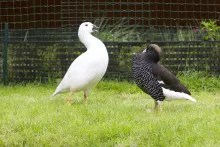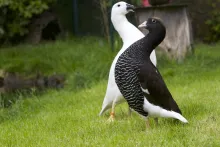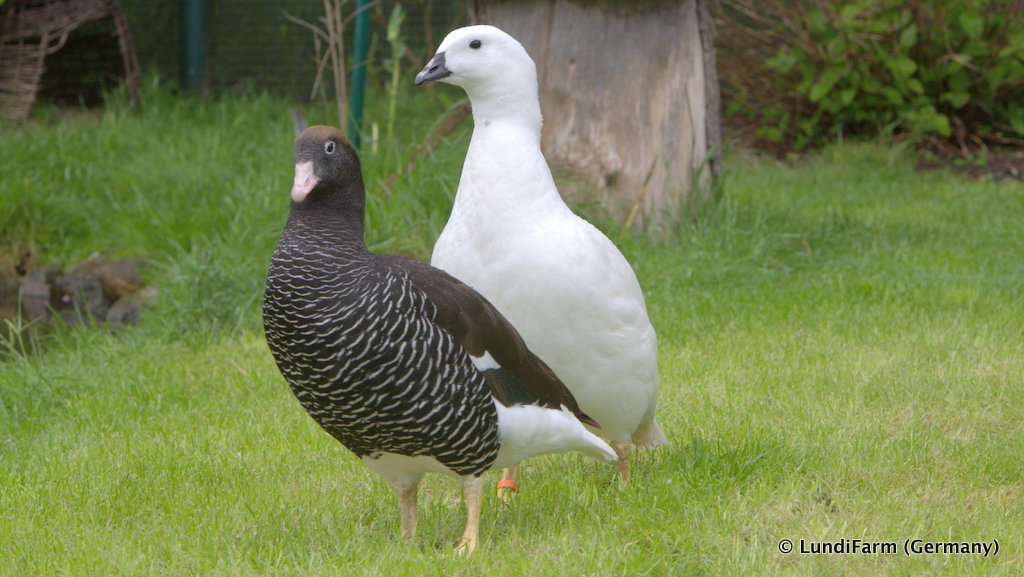
Kelp Goose (Chloephaga hybrida)
Species name
- Dutch name:
- Kleine Kelpgans
- English name:
- Kelp Goose
- German name:
- Kelpgans
- French name:
- Ouette marine
- Scientific name:
- Chloephaga hybrida
Scientific classification
- Order:
- Anseriformes
- Family:
- Anatidae
- Onderfamilie:
- Anserinae
- Genus:
- Chloephaga
Description
- Description:
Male:
The male is entirely white and slightly larger than the female. It has black bill with red or yellow patch at culmen’s base. The eyes are dark brown. Legs and webbed feet are yellow.Female:
Female has blackish-brown mantle, upper back, scapulars and tertials. The upper wing-coverts are white, except the blackish greater coverts showing green iridescent gloss. Primaries are blackish. Rump, uppertail-coverts and tail are white.
On the underparts, the brown breast and flanks are barred white, due to white-edged feathers. Belly, undertail-coverts and tail are white. On the white underwing, primaries are blackish.
Head and neck are dark brown, with slightly paler crown. The bill is pale pink to pinkish-yellow. The eyes are dark brown, surrounded by white eyering. Legs and webbed feet are yellow.Juvenile:
resembles adult female but its plumage is duller. It lacks the green gloss on greater coverts. It has indistinct barring on under parts, and blackish spots on belly, upper tail-coverts and back.
The young male shows very soon white feathers on head, neck and breast. The white adult plumage appears through the second year, with only dark tips to the primaries. Legs and webbed feet are dull greenish-yellow.Description Differences between Subspecies:
Greater Kelp Goose (Chloephaga hybrida malvinarum) -Male - Has a larger Bill with more crimson pink on it, longer legs and out weight the lesser by 3 pounds. The Wings are also longer.
Female - Very Similar to Lesser in appearance also But also larger like the male especially the wings, Feet and Bill. Has a white feather edging to black-brown under parts broader, producing bolder and therefore much prominent barring then its Cousin.
Standard Measurements
- Body Length (cm):
- The male (drake) of the Kelp Goose measures approximately 55-65 centimeters. The female measures approximately 55-65 centimeters.
- Body Weight (grams):
- The male will weight about 3480-3620 gram. The female will weight about 2040-2460 gram.
The weight is notoriously variable and can only be used as indication!
- Subspecies:
There are two subspecies:
- Chloephaga hybrida hybrida - (Lesser) Kelp Goose
- Chloephaga hybrida malvinarum - Falkland Kelp Goose
- Note:
Only the Lesser Kelp geese have been kept in collections very rarely, and bred very rarely. Their specialised feeding habits make captive management problematic. Kelp geese are generally hardy, and mostly aggressive particularly in the breeding season, so that pairs require a separate pen. A pen for a pair of these birds may be 80% grazing land to 20% water, with a minimum size of 200 square metres for the smaller species (e.g. Orinoco goose) and 300 square metres for the larger species.
Sheltered nest sites may be needed for species which nest early in the year. Ground-level nest boxes, open to the ground, 50x40x40cm (20x16x16 inches), with a ground level entrance hole and containing e.g. dry grass as nesting material.
- Breeding:
- The female Kelp Goose usually lays from 3-7 Off white eggs and incubates them for 28-31 days.
- Artificial incubating:
The ideal relative humidity for incubating most waterfowl eggs is 55% (ground nesters) and 40% (cavity nesters). The temperature is usually 37.4°C. Set ventilation as recommended by the incubator manufacturer. Eggs must be turned, either automatically or by hand, a minimum of 4 times a day. As the duckling develops there is a loss of water from the egg and the air sac gets bigger. In normal development of an egg with a 28-31 days incubation, the air sac occupies about a third of it three days earlier. Cleanliness is vital and ideally eggs should be moved to a separate hatcher at this point, where the humidity should be increased to 65% and even higher once they have pipped internally.
- Bird banding:
- Recommended closed leg band ring size for the Kelp Goose is 18 mm.The leg band ring can only be applied on a young goose at around 16 days old.
- It doesn't matter what leg that you band, but it's good to have a consistent system. Suggested: Left leg = Female, Right leg = Male
- Rearingfeed:
-
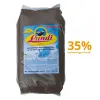
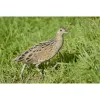

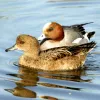


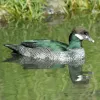 Floatable special rearing feed for all ornamental waterfowl species, even for problematic eaters. This ideally balanced complete feed with 35% protein content forms the basis for healthy growth and lifelong vitality. Made exclusively from wholesome and selected raw materials, Lundi Micro is also ideally suited for the year-round feeding of waterfowl.
Floatable special rearing feed for all ornamental waterfowl species, even for problematic eaters. This ideally balanced complete feed with 35% protein content forms the basis for healthy growth and lifelong vitality. Made exclusively from wholesome and selected raw materials, Lundi Micro is also ideally suited for the year-round feeding of waterfowl.
- Maintenance food:
-


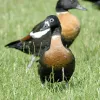


Floating full food for all sea ducks, green ducks, eider ducks and geese, especially in the moulting and breeding phase ideally suited. Packed with wholesome raw materials, natural vitamins and trace elements, this performance food with a protein content of 30% forms the basis for lifelong vitality.


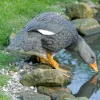
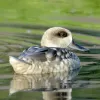
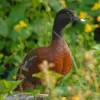


Floatable special complete food for sea birds with the highest nutritional requirements. Each chunk contains the complete nutrient spectrum. The high protein content of 35% ensures a healthy and species-appropriate diet. Spiral algae give a more magnificent coloration of plumage and sea salt promotes the salt gland.


